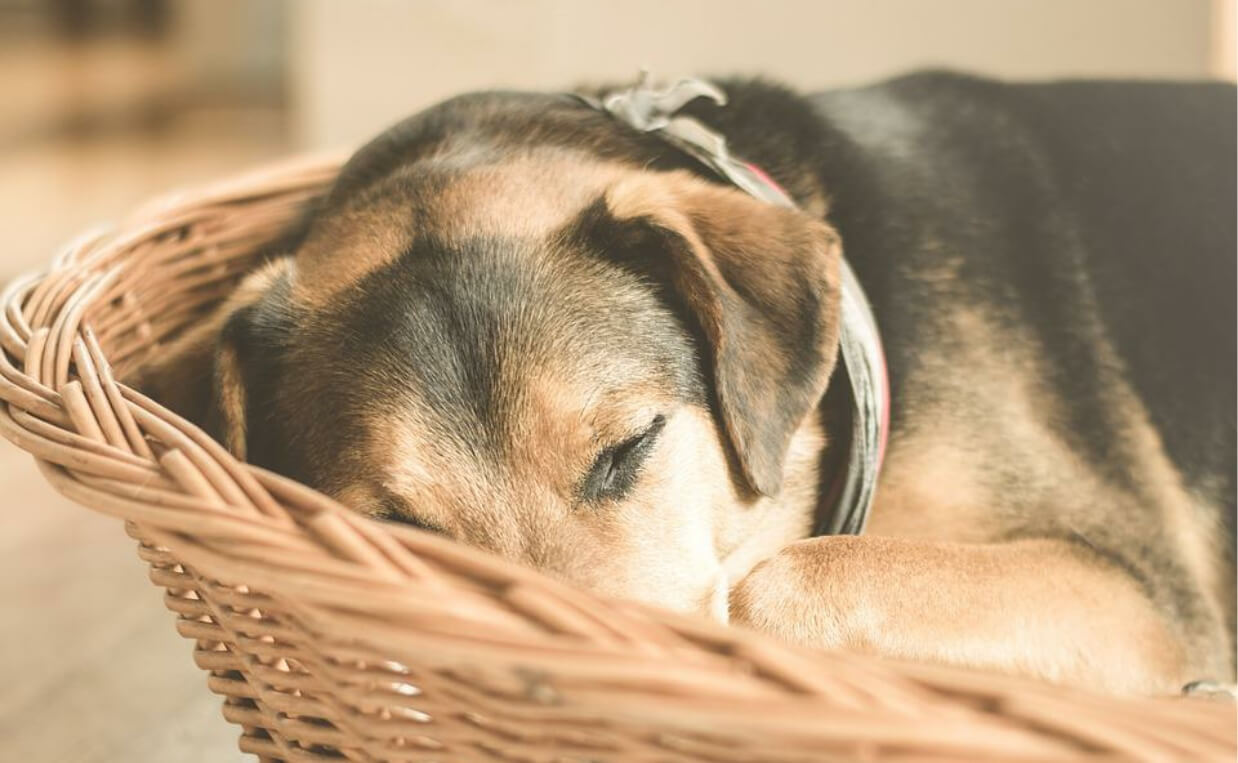
Just like humans, dogs sleep in various positions. We’ve all come across some strange dog sleeping positions.
The way your pooch lays when he or she sleeps says a lot about his or her behavior, personality, and more.
Dog sleeping positions are cute, fun to observe, and, more importantly, informative about a dog’s mental and physical state. Curious to know what various dog sleeping positions mean? Keep reading to learn more.
Dog Sleeping Positions and Meanings
-
The Side Sleeper Pose
The side sleeper pose is the most popular sleeping position in dogs. In this position, dogs lie on their side with their legs extended. This position leaves their limbs free to move during sleep, so you may see more twitching and leg kicks when they are sleeping on their side.
Meaning
When a dog is sleeping in this position it means the dog feels safe and relaxed. Their bellies are exposed, meaning they feel secure and comfortable.
-
The Lion’s Pose
This position is also called “The Sphinx” and is characterized by a dog sleeping with his or her head on top of their paws. The dog can also sleep in this position by tucking their paws and resting their back legs on the side.
Meaning
This position indicates the dog is resting, but ready to jump up and play or bark at a moment’s notice. Lion’s Pose sleepers are protective and devoted. They’ll typically snooze by your feet or at the front door. When dogs sleep in this position, they are resting, but not sleeping deeply. They are ready to wake up quickly if needed.
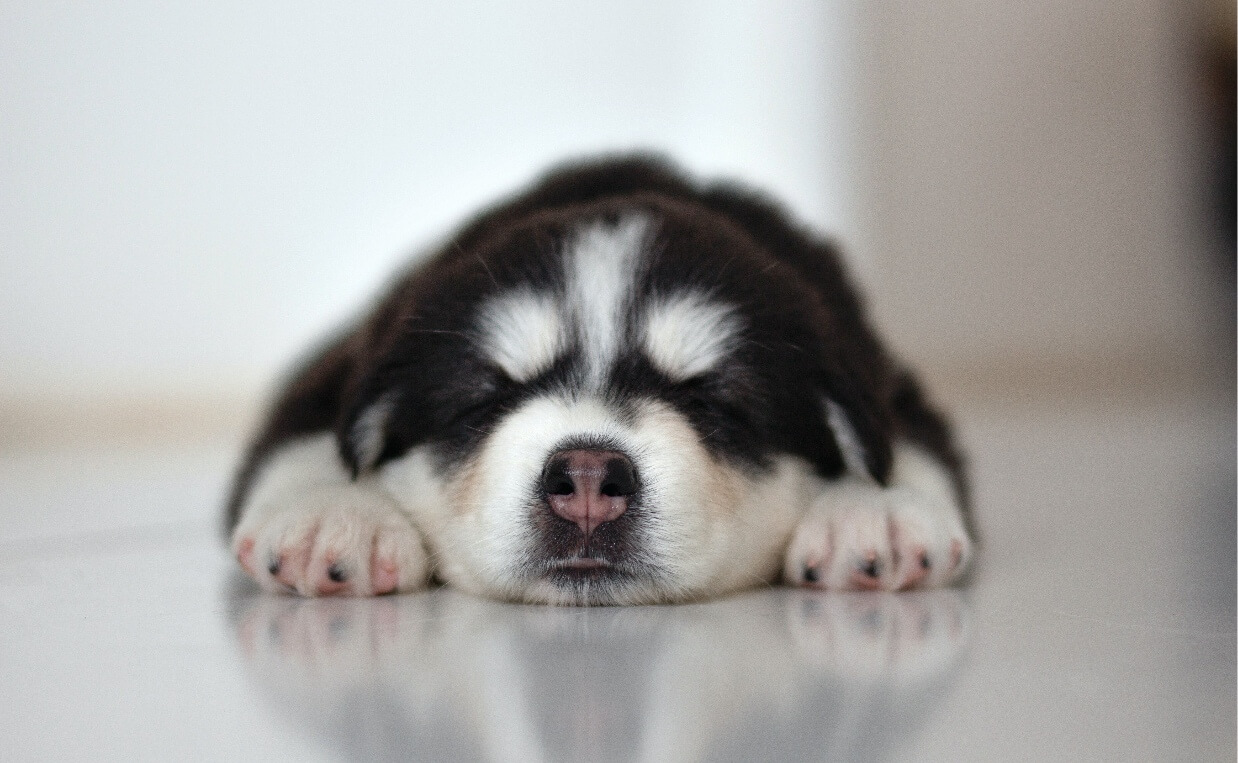
-
The Superman Pose
The Superman pose is when your dog is sprawled out on the ground or bed with their belly pressed to the floor with their front legs stretched forward and back lets behind them. This position is also called a “sploot” or “frogging”.
Meaning
Researchers aren’t exactly sure why dogs sleep like this, but they think it may have to do with temperature. Usually, dogs will do this when they are too hot. The surface they are stretched out on is usually cooler than other surfaces. For example, a dog may lie in this position on a cool, tile floor rather than on the warm carpet or bed.
Small breeds and puppies tend to sleep in this position more than larger breeds. Researchers think it’s harder for large dogs to sleep in this position. An elevated bed might help keep your pup cool if he or she tends to sleep in this position often.
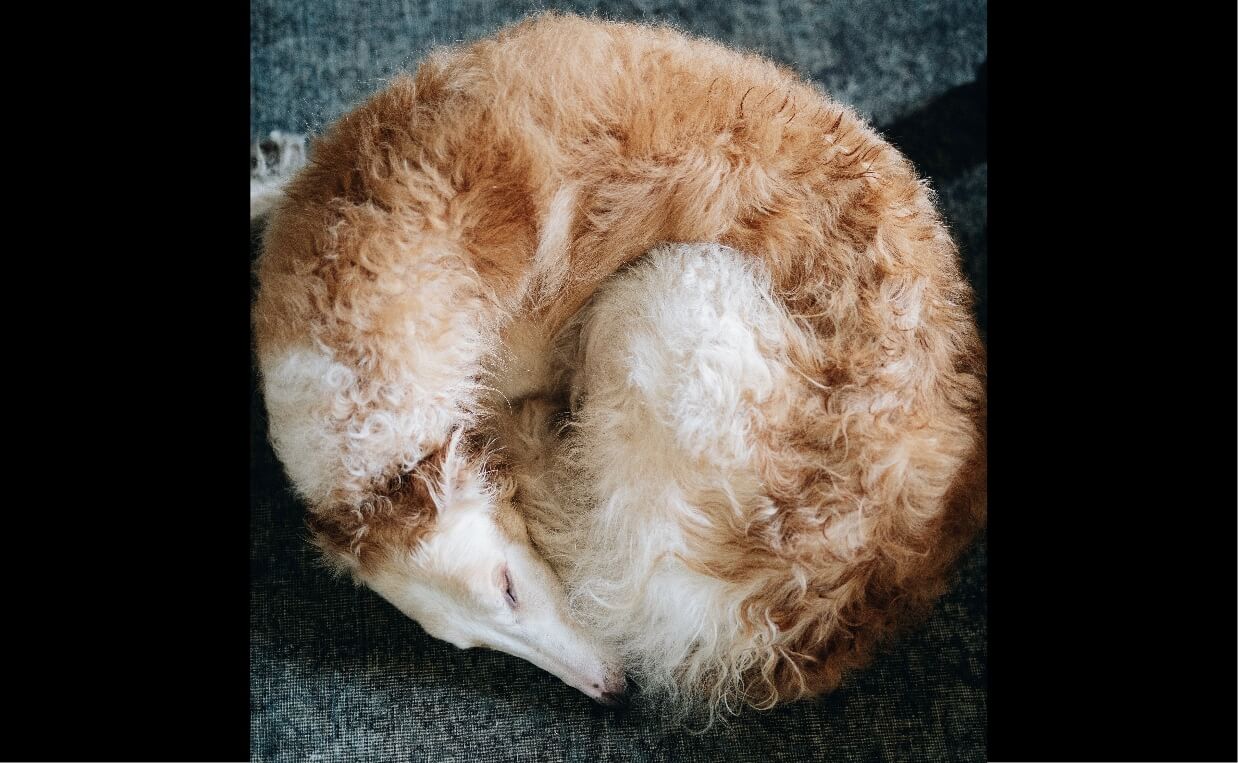
-
The Donut Pose
A very common canine sleeping position is curled up in a ball, nose-to-tail. This is also a common position for animals to take in the wild too, as it protects the vital organs, helps conserve warmth, and makes it easy to get up quickly.
Meaning
This position generally indicates a dog is seeking protection or still getting used to their environment. This is a common sleeping position in stray or new dogs getting used to their home.
This is also a favorite position for dogs when they’re cold. By curling up in a ball, they’re attempting to preserve their body heat. In the wild, this would have protected dogs from the elements when they slept outside.
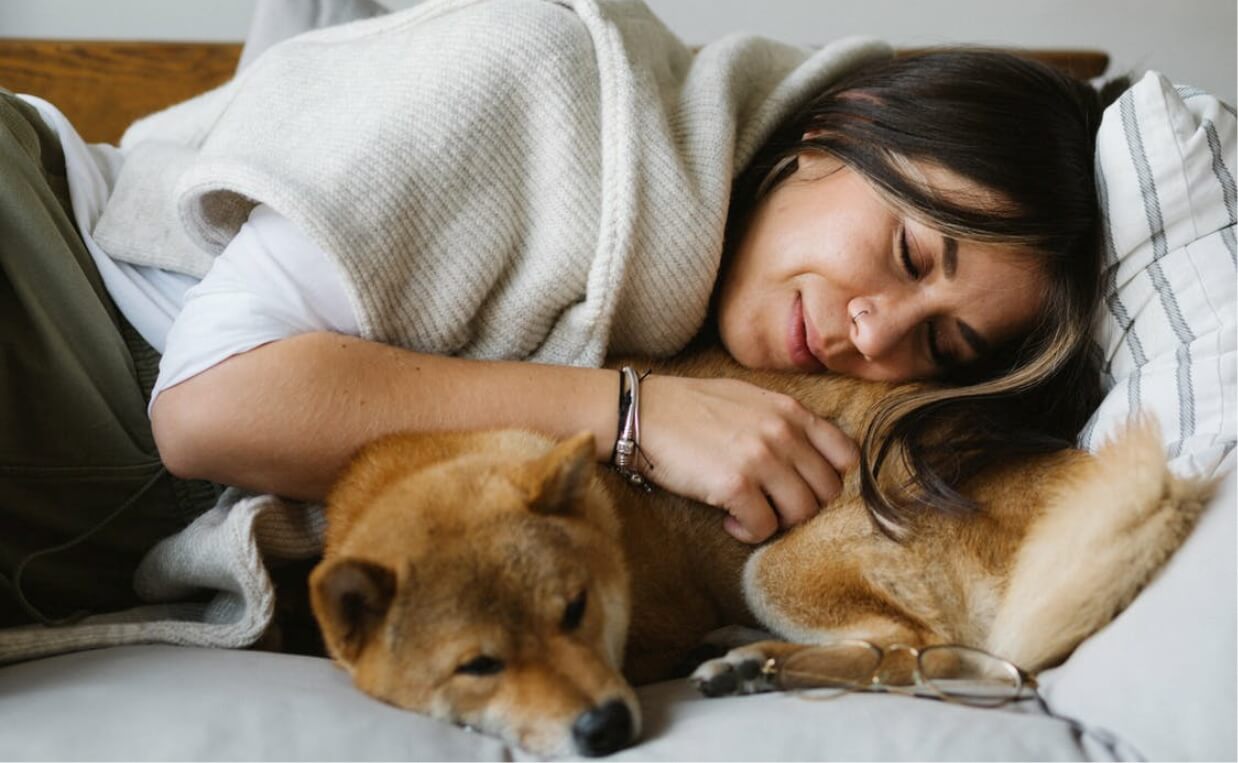
-
The Cuddler Pose
This is one of the most adorable dog sleeping pose. This is when your dog prefers to sleep with you or other animals. This is a great position for those that love to let their dog sleep in the bed with them.
Meaning
Dogs who love to cuddle are bonded with you or other pets. Sleep-cuddling is a holdover from when your dog was a puppy and snuggled up with their litter to keep warm. When they’re older, cuddling turns into a habit of comfort.
-
The Burrowing Pose
Some dogs like to seek out pillows, blankets or clothes to sleep under. These dogs prefer to sleep in the burrowing pose.
Meaning
When dogs sleep in the burrower position, they are searching for comfort and security. They may also be seeking to calm themselves down, similar to when you use a “thunder shirt” to help ease an anxious dog.
Burrowing under blankets could also be a way for your dog to create a “den” to block out distractions before bed, just like when a human uses a sleep mask to minimize noise and light.
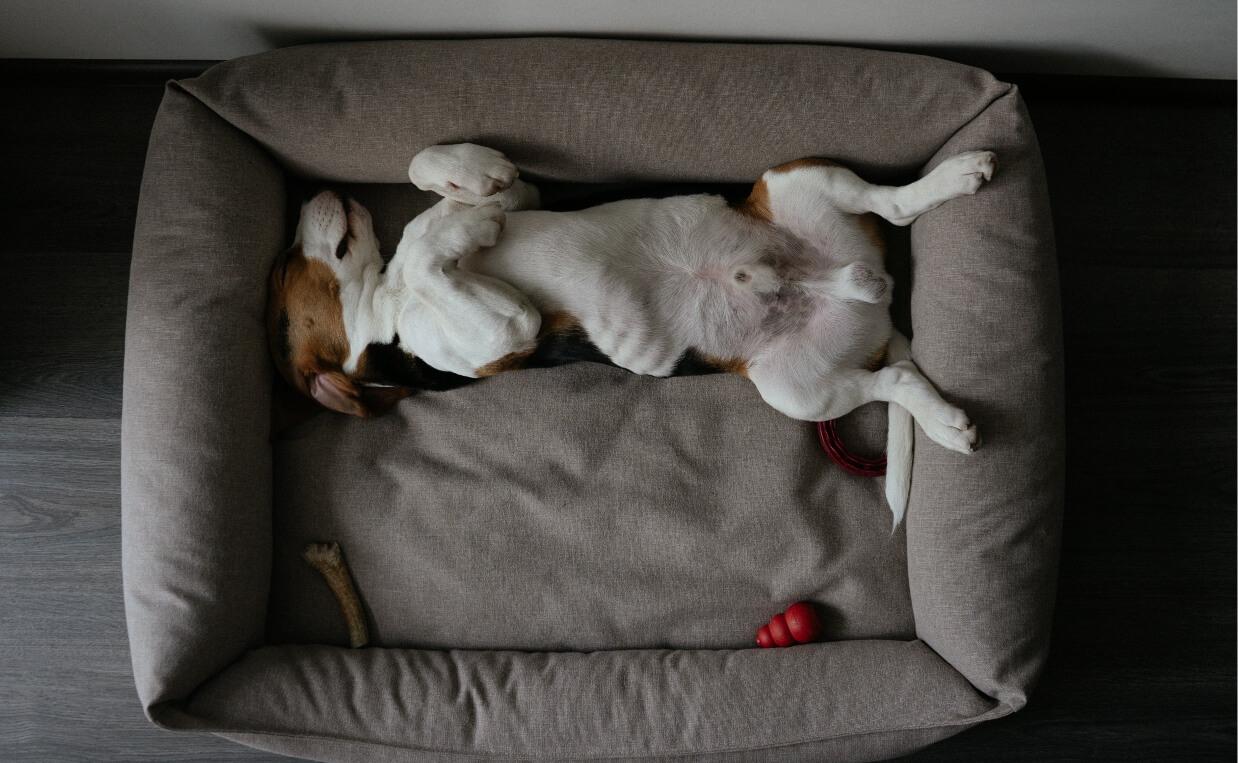
-
The Belly Up Pose
The belly up pose is arguably one of the cutest dog sleeping positions. The belly up position is just like it sounds. This position is when your dog lies on their back with their belly up and paws in the air. While this position may look uncomfortable, this is a sign of true comfort and relaxation in dogs.
Meaning
Dogs who sleep on their backs with their paws in the air may be doing this for a few reasons. One of them is to keep cool. Since dogs sweat through their paws and their belly is a source of heat. When they sleep on their back with their belly in the air and paws up, they are trying to keep cool.
This is such a vulnerable position to be in, when dogs sleep on their back with their paws in the air, it also means they fully trust you and their environment. Since they are exposing their belly and their vital organs to the world, you have to know they feel really secure to fall asleep in this position.
As dogs age, you’ll notice they may no longer sleep on their back as much, especially if they have arthritis. If you see this happening, don’t assume your dog is no longer trusting you.
-
Back to Back
Similar to the cuddler sleeping position, when a dog likes to sleep back to back, it means they like to cuddle up and get as close as possible by placing their back next to either you or another dog. In the simplest form, this position is a sign of love and comfort.
Meaning
Sleeping back to back indicates a sense of intimacy. When a dog sleeps in this position, they are showing you affection and trust. Dogs may choose to sleep this way with one person in the home they feel safest with. This may include other family members or other pets in the home.
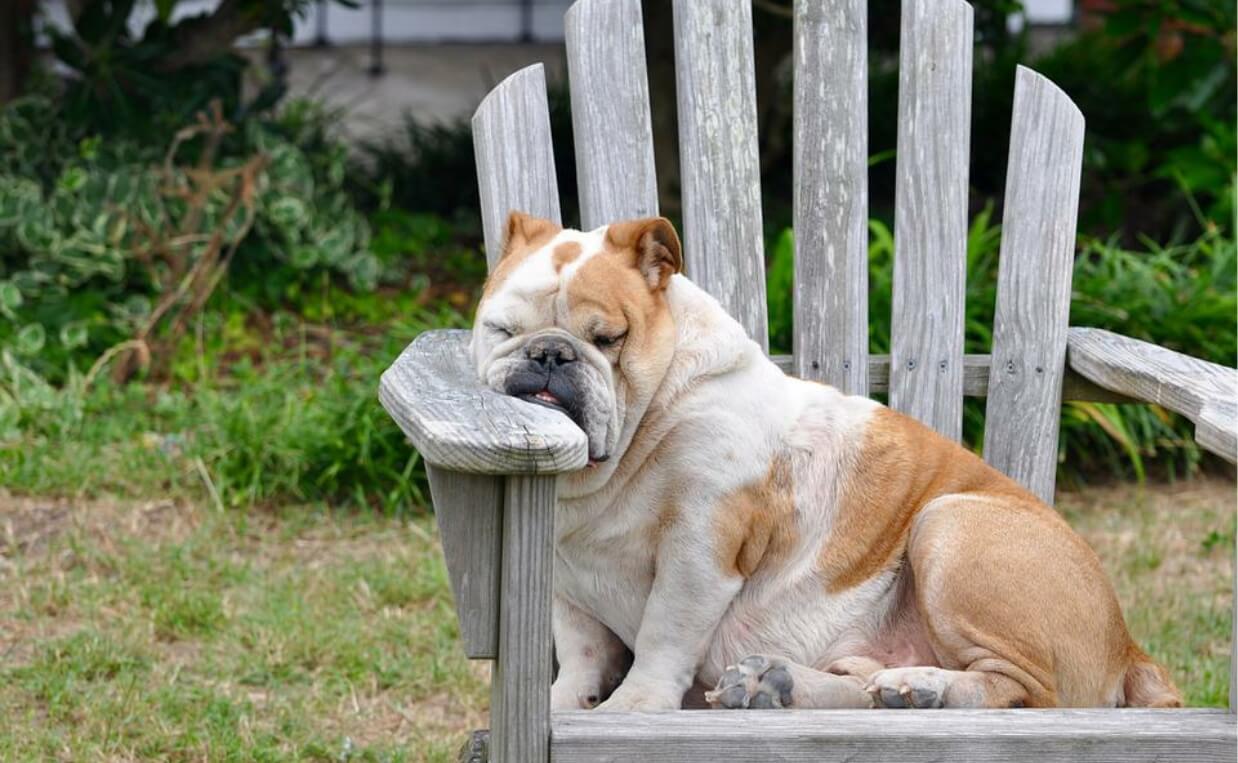
-
Head and Neck Raised
Some dogs seek out a sleeping position where their head and neck are raised. They will usually leverage the side of their dog bed or a couch cushion.
Meaning
If your dog likes to sleep in a position where their head and neck are raised, it could mean they may have issues breathing properly – something is commonly seen with chronic heart disease and other health problems.
If your dog sleeps in this position keep an eye out for worrying symptoms such as faster breathing rate, noisy breathing, or a reduced ability to exercise. If you notice any of these symptoms, make sure to contact your veterinarian.
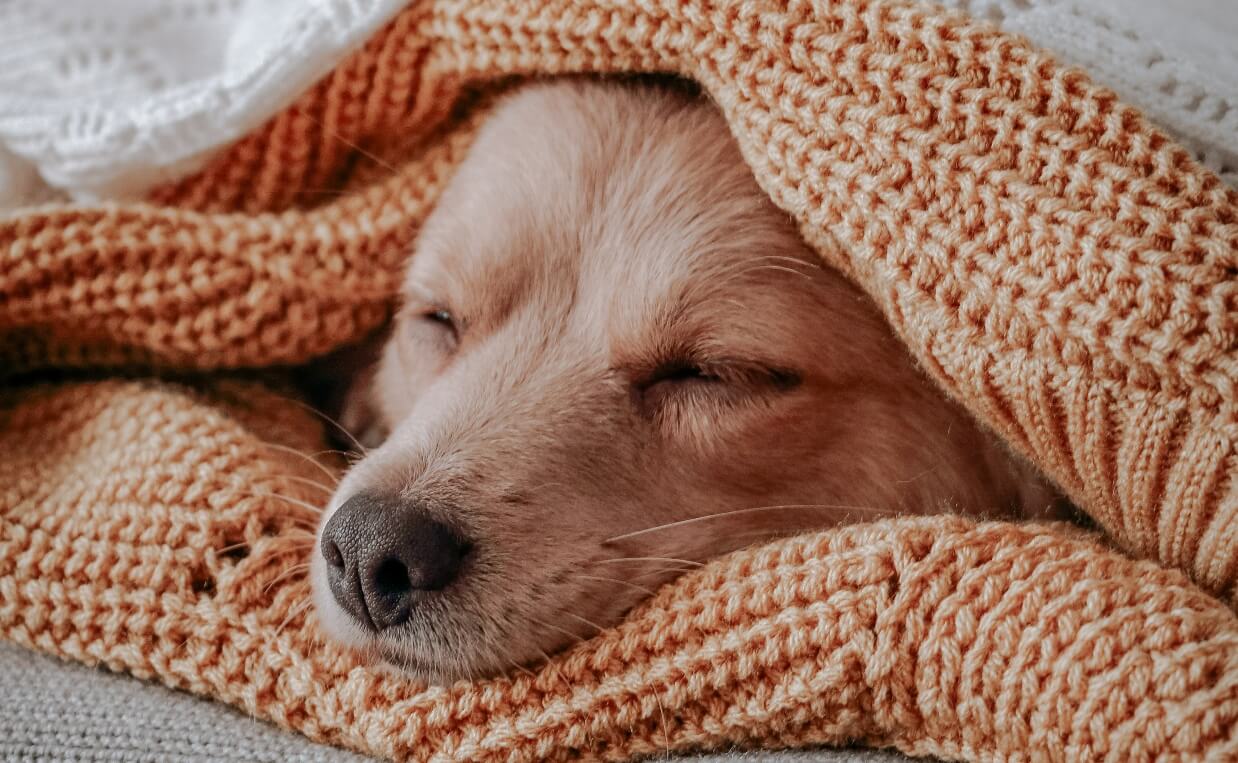
Dog Sleeping Behaviors
When your dog is asleep, you may notice him or her engaging in certain behaviors. These sleeping behaviors are normal and can give you insight into the quality of sleep they’re getting.
-
Dreaming
Yes, animals dream. While it’s difficult to uncover exactly what dogs dream about, we know the brain processes their activities of the day. So we can assume they are probably dreaming about going for a walk, chasing a squirrel or playing in daycare.
-
Twitching
Just like humans, animals twitch during sleep. It’s a normal part of the sleep cycle. When you see them twitching, it means they’re dreaming or moving between sleep stages.
-
Barking or yelping
If your dog barks or yelps during sleep, don’t panic. This is completely normal and may indicate they are reacting to something happening in their dream.
-
Running
You may notice this when your dog is sleeping on their side and their paws start to move like the dog is running. This is typically in response to a dream your dog may be having.
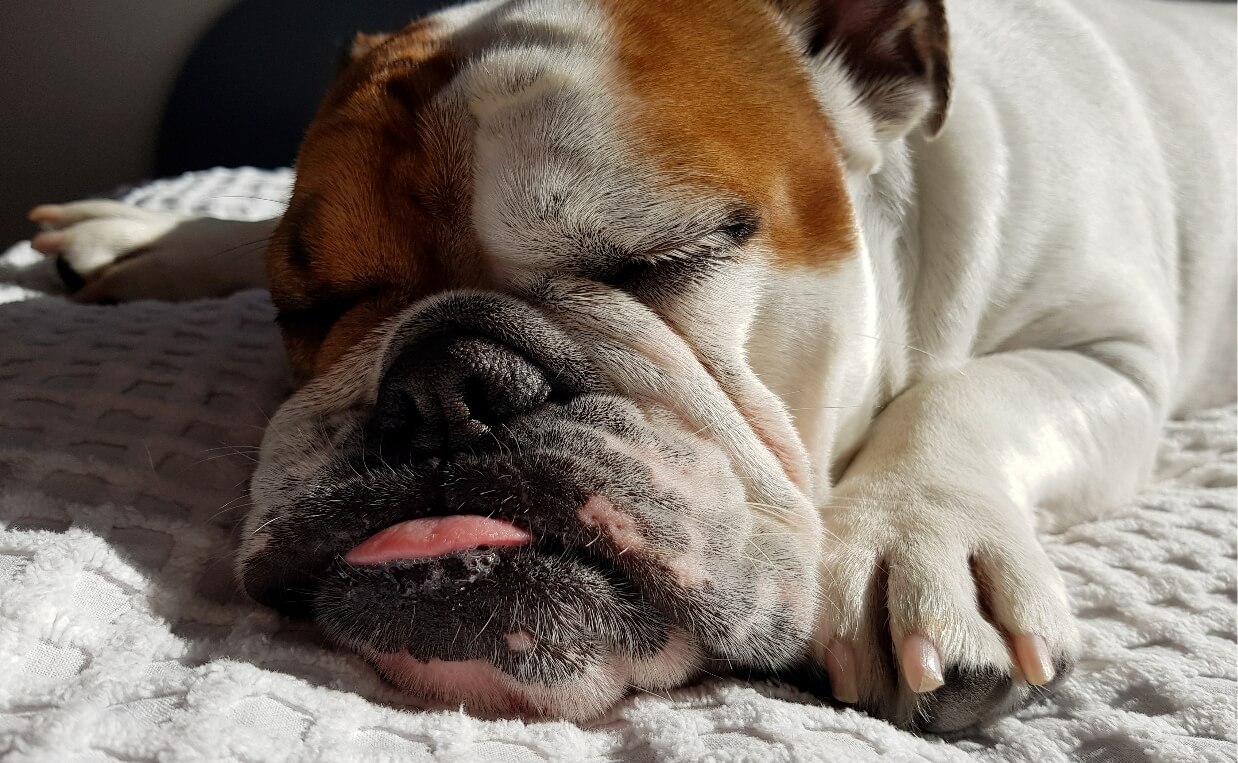
-
Snoring
Some dogs snore just as much as humans, but not all dogs snore. Snoring is most common in brachycephalic breeds, who have short noses and broad skulls, such as pugs, bulldogs, and bulldogs.
-
Circling and digging
Sometimes dogs will circle or dig into their bed before lying down to sleep. This behavior comes from dog’s ancestors, wolves. Wolves do this to dig down into leaves, dirt and snow to create comfortable sleeping area.
These are all normal canine behaviors, so if your dog is displaying these behaviors there’s no need to be concerned.
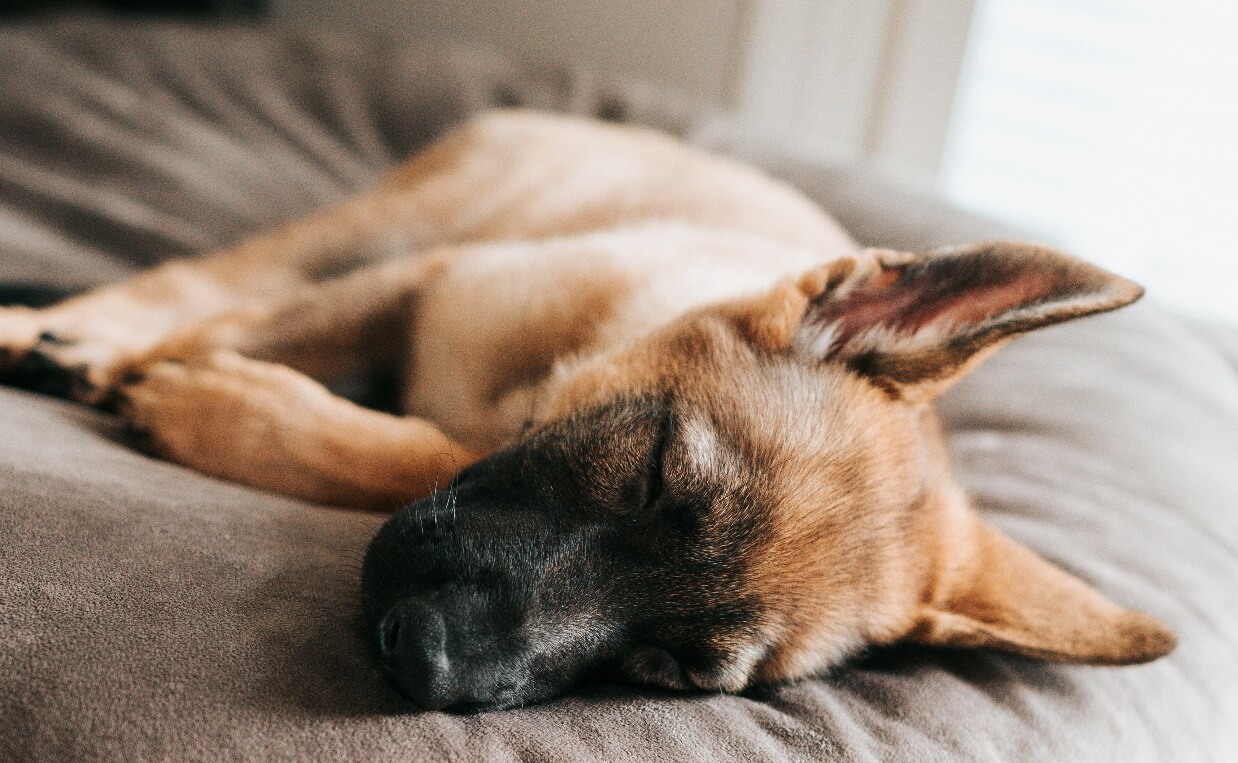
How Long Do Dogs Sleep?
On average, adult dogs sleep 8-14 hours per day. Puppies and senior dogs sleep between 18-20 hours a day. Typically, dogs will sleep 12-14 hours a day. Of course, this can vary based on your dog’s breed, activity level, and personality. Usually, dogs will sleep more on days they have been more active.
In general, dogs sleep the most between 9:00 pm and 6:00 am, although most take a nap sometime during the day.
Puppies need significantly more sleep than adult dogs because they are still growing and developing. Senior dogs will also sleep more because they have less energy and are aging.
If you notice your dog is sleeping a lot, staying awake longer than usual, or waking up often during the night, consider scheduling an appointment with a veterinarian to check for underlying issues.
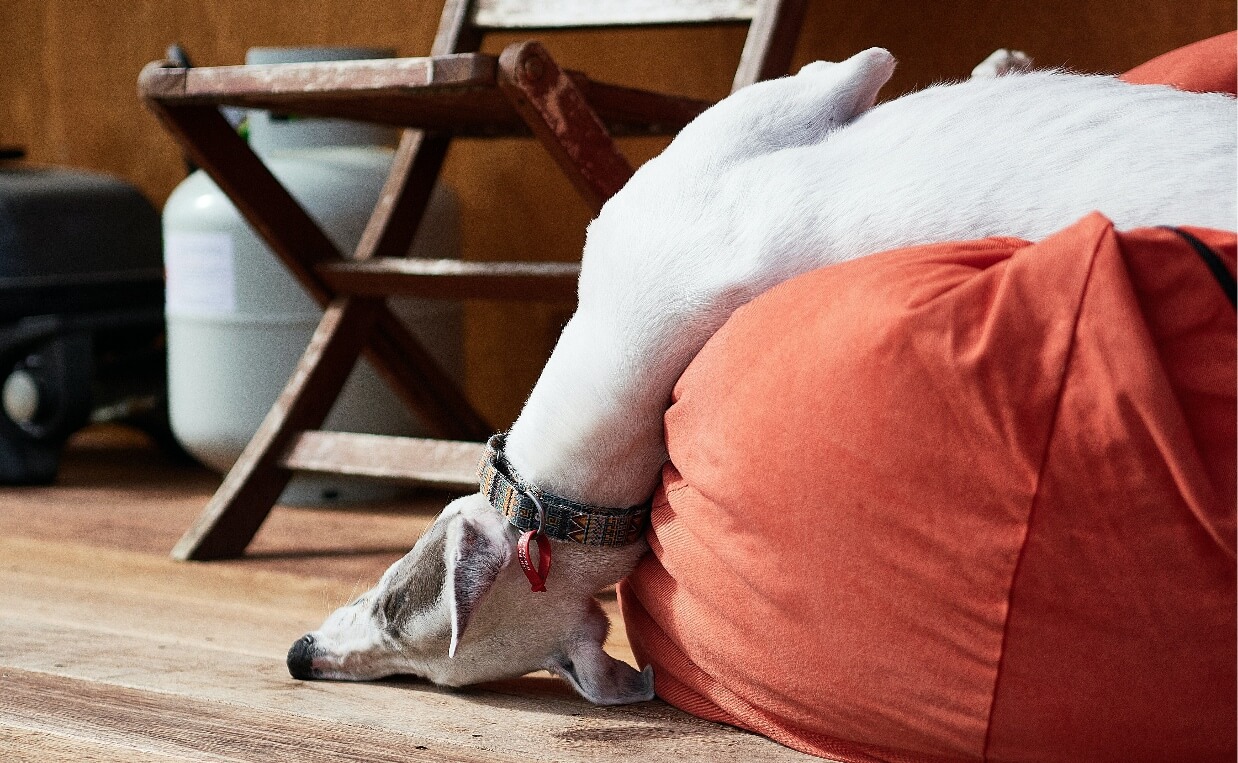
Final Thoughts
It’s important to always keep an eye on your dog’s sleeping habits. The position they sleep in or the amount of sleep they get can be clues to how they are feeling – both physically and mentally.
Dogs who are sleeping less or in new positions or locations may be suffering from an illness or injury, so it’s important to take your dog in to be seen.
To ensure your dog gets the best sleep possible, make sure his or her sleeping area is comfortable by providing a comfortable dog bed, favorite toys, and keep water nearby.
In what position does your dog sleep? Does your dog have any cute, strange bedtime habits? Please share in the comments below…

 Top 10 Tips to Calm a Hyperactive Puppy
Top 10 Tips to Calm a Hyperactive Puppy Why Dogs Turn on Their Owners: Understanding the Causes and Prevention
Why Dogs Turn on Their Owners: Understanding the Causes and Prevention Does Neutering a Male Dog Reduce Marking and Aggression?
Does Neutering a Male Dog Reduce Marking and Aggression? How Service Dogs Reduce PTSD Symptoms: Unleashing the Healing Bond
How Service Dogs Reduce PTSD Symptoms: Unleashing the Healing Bond 9 Reasons Why Dogs Howl
9 Reasons Why Dogs Howl






I have been very enlightening on pets behaviors, sleeping patterns, and now I know why my pet fixes her blanket before she goes 2 sleep.
I’m glad you enjoyed the post! A fun part of having a dog is understanding why they do what they do. Thanks for sharing and I hope you visit us again soon!
I love this! I’ve been wondering how comfortable it can be to lay belly up on top of my marble fireplace hearth! But I guess he IS comfortable! He’s an Australian Shepherd so he runs hot! I think the cold marble helps keep him cool. He also likes to sleep on top of my air conditioning vents! I keep my house at like 72 or 70 degrees! lol
Thank you for visiting our blog and sharing your experience! Dogs are amazing and so smart to figure out what they need. We appreciate your comment and hope you’ll visit again soon!
Hi guys, my dog Mia has to touch her nose on mine before sleep then she wraps her body around my head lol its so cute to see
Awww how sweet! Thanks for sharing!
My beagle lays against things what does this mean?
It’s probably just a way he comforts himself. Does he lean against you sometimes too? That is a sign he loves and trusts you!
Our Beagle always makes sure her nose is under or between something ( a pillow/pillows, blanket, sheet when sleeping. Even in her crate she bunches up a small blanket & gets her nose under it. Is she protecting it since Beagle noses are so sensitive?
It’s always hard to say exactly what an individual dog is thinking, but it may be possible your dog is displaying a burrowing behavior by getting her nose under her blanket.
My beloved pit mix would toss the bed sheet and blanket before turning her back to mine to sleep. Now it makes sense
Thanks for stopping by the Canine Campus blog! I’m glad the post helped you understand your pup a little bit more! Come back soon!